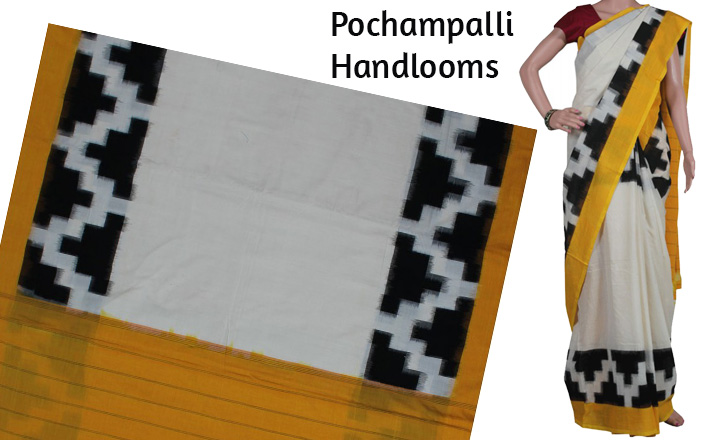The Legacy of Telangana’s Unique Handlooms

Pochampally and the nearby villages in Yadadri-Bhuvanagiri district of Telangana are renowned for world-famous Ikat designs and dress materials. The village has many traditional looms, and many of these designs are more than a century-old.
Popularly called as the Ikat or tie and dye weave, the uniqueness of Pochampally fabric lies in the transfer of design and colouring onto warp, for weaving them deftly together.
Pochampally Ikat is also known locally as Chitki, Pogudubandhu, and Buddabhashi in the region of Telangana where it is produced, whereas in other parts of India, the handloom design is popularly known as Pochampally. The Ikat pattern has its own unique design, which is different from other Ikat producing centres of India. There are more than five thousand looms producing this textile in this region.
Process of Making Pochampally Fabric
<The fabric used is cotton, silk and sico, which is actually a mix of silk and cotton. Ikat represents a weaving form wherein the warp, weft and even both are tie-dyed before they are weaved to create any designs on the finished fabric. Great care is taken from tying of the resistant areas with the water repellent material. The precision of this wrapping decides clarity of the design. After wrapping, these warp threads are dyed. When these are eventually finished and unwrapped, the areas under these ties retain the original colour. Numerous colours are then added once the additional wrappings are done.
Here the threads and colours created by skilful weavers are used in the process of making beautiful sarees and dress materials. Designs are worked out usually on graph paper before the actual weaving process begins at the Pochampally handlooms. The natural movement during the process of weaving gives the Ikat designs a form of feathered edge, which is indeed a highlight of this technique.
Pochampally handlooms are widely known for the durability of the colours that are used in the yarn. The intricate geometric designs are mastered by the hands of skilled weavers here who have been making beautiful sarees and dress materials at the several handlooms in the villages of this region for decades.
Pochampally village has made it to UNESCO tentative list of world heritage sites under the "iconic saree weaving clusters of India". Pochampally represents a prestigious weaving tradition of Telangana. Pochampally saree also received Intellectual Property Rights Protection or Geographical Indication (GI) status in the year 2005. sought-after wood form, with a charm of its own.